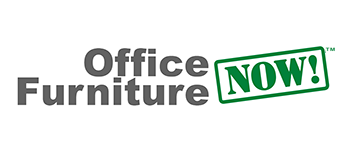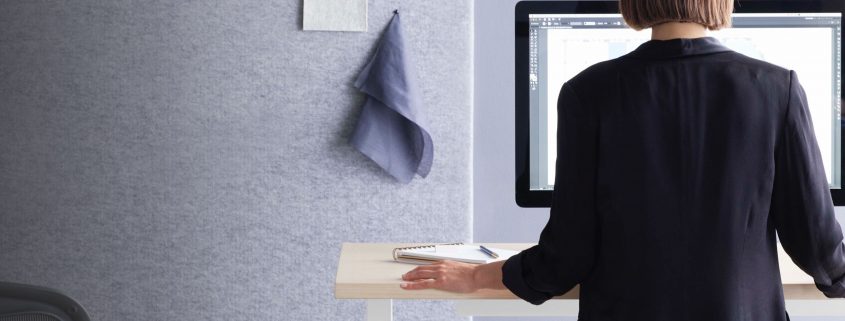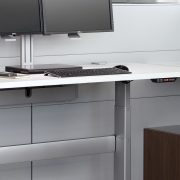Extra Sensory Perception In Office Design
With a little bit of sensory perception, Herman Miller has come up with an intuitive way to understand the metrics of how your team utilizes the technology of a well-designed office space. Innovative office furniture manufacturers are always looking for ways to improve the user experience and gather data on what works and what doesn’t within the framework of office design and user experience.
With the development of sensors that can come pre-installed on desks, or retrofitted to any existing work surface, Herman Miller users are able to capture data on-the-fly which is then accessed through a dashboard, giving companies insight into how their employees utilize their workspaces.
Establishing Sensory Perception At Work
This may sound unorthodox, but it’s really all about gathering data to help personalize your work environment and make the user experience better. It’s all achieved through an app called Live OS. On fixed-height desks, Live OS only tracks when people are present. But when used with sit-to-stand desks, it acts more like a furniture Fitbit, allowing the user to set preferences for things like programmed desk height settings throughout the workday. These settings can then be recalled via the app at any connected sit-to-stand desk around the office by simply tapping a button.
This smart technology allows individuals to set activity goals, like standing for 20 minutes out of every 60. So they don’t forget if they are preoccupied with the task at hand. When it’s time to change postures, the desk prompts the shift via a soft buzz. The app allows the flexibility of working to custom settings anywhere in the office.
For those who aren’t used to moving while they work, the app will gradually progress toward set activity goals over a period of weeks to acclimate them to the change. The system is designed to encourage the change gradually so that it becomes a normal behavior rather than an occasional habit.
Herman Miller has been exploring the use of sensors since the late 1990s to help provide data on the everyday work environment experience and provide organizations with data-driven insights toward more productivity on the job.
Real estate still tends to be the second highest investment for a company, after people. But until now there has really been no way to measure data on how the workspace is actually used. A generation ago, companies didn’t have access to the kind of data that Live OS promises — but they also didn’t need it as much.
As office design has become more collaborative and user-centric, it has also become more agile. Technology continues to play a pivotal role in these changes. Employees who used to have no choice but to stay close to their desks for most of the day, because that’s where the phone rang and the computer sat, can now function anywhere, around the world or the office space, with mobile technology and the internet.
Encouraging Movement
Office planners have begun to adapt to this mobile work ethic by incorporating zoned workspaces designed to encourage movement around the office throughout the day. People suddenly have the amazing ability to personalize their workspaces, book conference rooms on the fly, and digitally connect to chairs and tables for a more ergonomic day at the office.
Even though office design has progressed to a more agile working environment, one thing has not changed: many employees still sit for long periods of time for the tasks they perform. Technology has evolved in more efficient directions as laptops have gotten faster but smaller in size, causing many people to hunch over them during periods of concentration, exacerbating physical strain.
Research has concluded that adjustable sit-stand desks often go unused. Not because people don’t want them, it is simply a change in routine many forget about. And people often don’t understand that the goal is neither sitting, nor standing, but transitioning between the two throughout the day.
Being able to customize your work environment to your personal needs plays into the current trend of the living room model that is showing up in office design. Providing a personal zone of comfort that makes you feel at home wherever you work helps you thrive more in your tasks. The goal is creating a user-centric environment that allows you to focus more on higher thinking and less on an attachment to your desk.
The human component is essential to the success of any office design. Technology strives to fit into it as inconspicuously as possible. Gathering data for constant improvement in furniture design, functionality and usability are important to more than just a beautiful office space. Spending a third of your day in an environment that functions seamlessly with your aesthetic, how you work, and your productivity is what the sensory experience is all about.
 MEET ERIKA BARNES: Erika brings a lengthy retail management career to her furniture sales acumen. Her creative mind and excellent customer service will be a strong asset in partnering with you to create an agile workspace that encourages movement. Connect with her via email ebarnes@officefurniturenow.com or by calling 888-910-3769 x131. For more inspiration visit us on Facebook, Pinterest, and Twitter!
MEET ERIKA BARNES: Erika brings a lengthy retail management career to her furniture sales acumen. Her creative mind and excellent customer service will be a strong asset in partnering with you to create an agile workspace that encourages movement. Connect with her via email ebarnes@officefurniturenow.com or by calling 888-910-3769 x131. For more inspiration visit us on Facebook, Pinterest, and Twitter!




